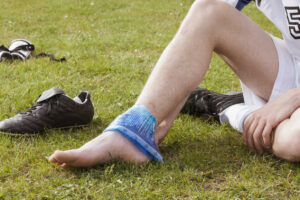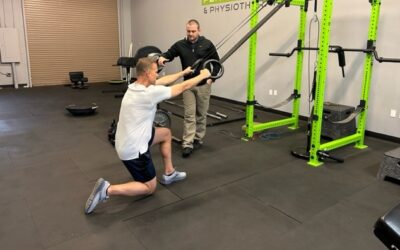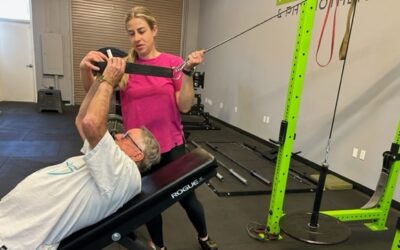We have all been there. You are playing a pickup basketball game and you step awkwardly. Something strange happened in your ankle and immediately you know what happened. You got an ankle sprain . Or maybe you were over-served by the bartender one night while you were wearing shoes that looked oh-so-good on you- but they may have been a poor choice considering you had to balance in heels all night. You stepped off a curb awkwardly and went down, grabbing your ankle almost immediately. Yup, you sprained your ankle.
We all have our own story (or most likely stories) about how we rolled our ankle. It is now swollen, painful, and you aren’t quite sure what to do next, even though you have sprained it a few times before.
Ankle sprains are very common. Nearly 14% of all injuries in sports and physical activities are ankle sprains.
So what should you do?
Easy. This article will help you out the next time it happens (because odds are it will).
What is an ankle sprain?
Between joints in our bodies, we have structures called ligaments that help hold those bones in place. A sprained ankle is really referring to the fact that you sprained a ligament. A sprain just means that the ligament was stretched beyond what it is normally allowed to stretch. These sprains c an result in tiny microtears in the ligament, or can result in a complete rupture of the ligament. There are different classifications to grade the severity of the sprain based on the amount of tearing in the ligament.
Types of ankle sprains
- Inversion, or lateral ankle sprain. This is the most common form of ankle sprain. This occurs when the foot rolls inward. This causes damage to the ligaments on the outside of the ankle (hence why it is called a lateral ankle sprain).
- Eversion or medial ankle sprain. This is the least common form of an ankle sprain. This occurs when the ankle rolls outward. This will cause damage to the ligaments on the inside of the ankle. Caution must be taken with this kind of ankle sprain because there is a likelihood of a fracture.
- High ankle sprain. This occurs in the ligament that holds the tibia and the fibula together. Your ankle is typically forced upward and outward to cause this kind of injury. This type of injury is typically from contact (i.e. someone landing on your foot to tackle you). This is usually the worst type of ankle sprain and requires the longest recovery time.
When to seek medical attention
Again, we have all likely sprained an ankle before. We know that they heal. They are just a son-of-a-gun to deal with and always happen at the worst times. But when should you seek further medical attention for it? This is tricky. There are special assessments we use in physical therapy to evaluate you, but that is beyond the scope of what I would recommend you do to assess. A good rule of thumb is if you are unable to bear weight on your leg, especially taking at least 4 steps, then you should get your ankle evaluated by a healthcare professional.
Treatment for your sprained ankle
There are so many tales of how to heal a sprained ankle fast. Most of it is trying to sell you something you don’t need. For instance, if someone is telling you that you need kinesiotape, scraping, cupping, dry needling, or laser treatment, it is likely they are trying to get your money. Although these currently don’t show that they will harm your recovery, there is just no good evidence that any of these modalities will help you heal your ankle sprain any faster. They are sold as tools to help break up scar tissue, release adhesions, and change the chemistry around ligament healing… all hogwash.
I’m sure you have heard of the RICE method (Rest, Ice, Compression, and Elevation) or PRICE (same as RICE but add Protection). Those were the gold standards for awhile. But what we have realized is that they are both very passive and don’t really help with an active recovery. Actually, promoting rest and immobilizing the ankle could make the healing process take longer. What gets better by sitting around and doing nothing?
You could use ice and compression. Those can be used as pain relievers, but keep in mind that they don’t accelerate the healing process.
What you should be thinking about when recovering from an ankle sprain is “PEACE and LOVE”. This stands for: Protection, Elevation, Avoiding anti-inflammatories and icing, Compression, Education, Load, Optimism, Vascularization, and Exercise.
Why no anti-inflammatories? Because inflammation is necessary for the ligaments to heal. It creates an environment to allow for the correct cells to begin and continue the healing process.
The most critical component of healing an ankle sprain
Exercising and Load Management.
That sounds so simple, but what does it actually mean? Should you be performing jumping jacks 3 days after you sprain your ankle? No.
First, pain should guide your recovery back to your normal activities. You should start very basic by trying to gain your ankle motion back and bearing weight equally through the legs.
From there, there are a lot of ways to take your recovery. All should be individualized by what you are looking to get back into. This is not only for athletes, but for people who have rolled their ankle by chasing after their kids as well. You need to slowly progress back into those activities and there are exercises to help with that based on where you are in your recovery.
If you are having trouble getting back to your regular, everyday activities or competing in your sport because of a sprained ankle, we can help! Reach out HERE to discover how we can get you back faster, stronger, and more resilient!




